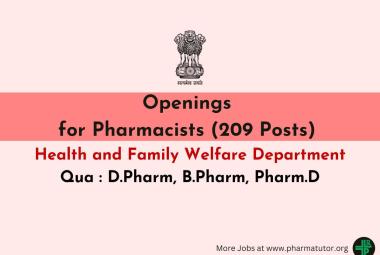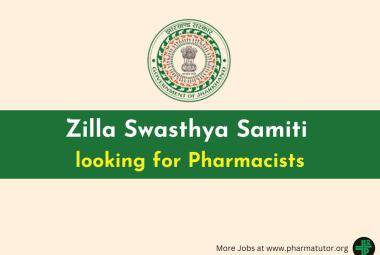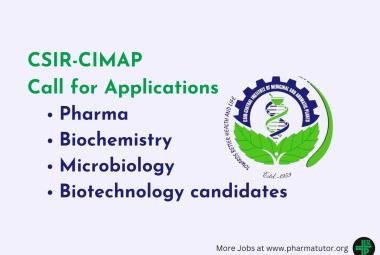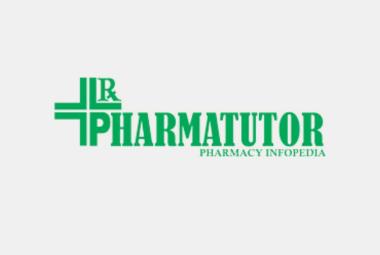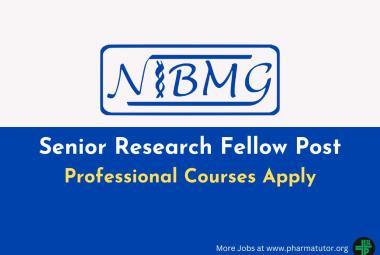Dr. R. S. Thakur
Former Secretary, Pharmacy Council of India
Email : drramsthakur@gmail.com
Abstract
Since 2010 every year 25th September is celebrated as World Pharmacists Day (WPD) across the globe, under the aegis of International Pharmaceutical Federation (FIP). For this international event every year a theme is declared by FIP and adopted by member organizations that reflect the importance of pharmacist in health care. The theme for 2025 is “Think Health, Think Pharmacist”. The role of pharmacist in health care has been deeply explored by the World Health Organization (WHO) and widely publicized for global attention and success of the health care system and achieving the much cherished goal of “health for all”. Pharmacists are internationally recognized professionals, who are uniquely educated and trained for committed public service to achieve the goal of safe and effective treatment of every patient they serve. Pharmacists practice to clinically assure safety, efficacy and economy of every medicine dispensed by them. Pharmacists are concerned about their patients' health and wellness. They provide state-of-the-art pharmaceutical care to meet the goal of “Health for All” and play a vital role in the health care system through the medicines they dispense and information that is provided about the safe use and potential hazards associated with improper use of those medicines. The pharmacist helps patients get well and ensure to protect the patients from untoward effects of medicines. Professional commitment and the principal goal of pharmaceutical care are to achieve positive outcomes from the use of medicines which improves patients' quality of life with minimum risk or health hazard, whatsoever.
Pharmacists strive to
1. Cure disease;
2. Eliminate or reduce symptoms;
3. Arrest or slow a disease process;
4. Prevent disease;
5. Diagnose disease; and
6. Alter physiological processes for desirable result in the patient'shealth.
Thus Pharmacists sincerely work for optimizing medication use and improving patient health safety issues. Their role in building healthy nation is well recognized and rewarded globally. This WPD theme portrays these essential aspects of pharmacists’ role on a wide health care canvas.
Introduction
In meeting the goal of a healthy society, medicines play a crucial role in diagnosis, treatment, mitigation and prevention of diseases. The quality, potency and safetyaspects of modern allopathic medicines are the most important factors for enjoying utmost benefits and avoidingpotential untoward effects on health and life of mankind.The modern medicines are potent and their indiscriminate use can devastate health and life. These intricacies emphasize active involvement andprecise supervision of pharmacist so that rational prescribing, accurate dispensing, proper patient compliance and medication regimen adherence can be assured in best interests of the patients.It is encouraging that the WHO and FIP have consciouslyundertaken thispublic health issues as health is directly related to happiness and welfare of people.It is very well realized that access to quality medicines and comprehensive counseling about the medicines to the patient play vital role in overall success of the treatment. Substandard, adulterated, spurious, misbrandedand counterfeit medicines pose massive threat in the plight to achieve healthcare objectives. [1,2] Keeping these ground realities in mindWHO and FIP have collectivelydesignedguidelines onGood Pharmacy Practice (GPP) with a mission to contribute to health improvement and help patients to make best use of their medicines.[3]In the perspective of the theme of WPD 2025 it is imperative to examine the issues related to health, medicines and pharmacist’s various roles in health care under specific sub-headings.
Health
This year’s theme links health and pharmacist and therefore, it is necessary to throw light on both health and pharmacist to justify the importance of the theme. As early as in 1948 WHO [4] defined health “a state of complete physical, mental and social well-being and not merely absence of disease or infirmity”. This definition has three key aspects like physical well-being, mental well-being and social well-being which are important for the reason that these cover specific aspects of life and are interlinked to overall maintenance of health. Physical well-being relates to absence of disease and natural function of the body for all practical purposes. However, the mental well-being relates to precise reaction to environmental stimuli in terms of emotional outburst or patience, psychological effect of situations around the individual as also memory functions and ability to recognize objects and contents perfectly. On the other hand social well-being is a relationship oriented feelings in inter-personnel context including social events and enterprise of togetherness. These three components of health are elaborated below:-
Components of Health
Physical health
It represents normal physiological function of human body and thus absolute wellbeing of mental functions and social acceptance as a noble healthy person. Any deformity in physiological function of any organ of the body unless reversed successfully, not only causes physical damages but also gives mental stress, worries and behavioral change. It is the behavioral change due to mental stress that adversely affects social wellbeing due to visible worries and distraction from usual activities.
Mental health
No individual can perform normally under mental stress. The ability, capacity and performances are qualitatively affected depending upon the intensity of physical health deformities. After all it is the brain which coordinates functions of various organs and limbs. Therefore, reflection of physical distress is clearly demonstrated in mental wellbeing. Positive interaction between mind and body is adversely affected in case of compromised mental wellbeing. Interventions become essential for restoration of physical health to harmonize mental health.
Social health
It is more aptly related to performance of social obligations, managing work place challenges, and leading quality life. This parameter is relative to everything around the individual – the society at large and the community in particular. Here, age related factors, chronic disease related factors; long-term therapy related factors influence the most. A dynamic balance between the inevitable changes and challenges in health conditions and performance related limitations need to be reached out. Social health is stimulus to mental health and a catalyst for reducing the worries of physical health irrespective of age group.
In achieving the goals of health, medicines play a very important role and pharmacists serve in the frontline to provide rational, safe, effective and economic medication.The preventive and prophylactic aspects are equally important in reducing the burden of disease. At the same time special attention is to be paid to the issues of nutrition, hygiene, habits and physical activities to acquire immunity and fight against communicable diseases, avoid non communicable diseases and lead healthy productive lifefor which health education contributes a lot.
Importance of Health
Health has impact on quality of life and overall performance to demonstrate individual’s knowledge, skill and expertise and thus an indicator of well-being.A balanced and optimized lifestyle helps in maintaining good health and thus leads to achievements and successes in life. The individual remains happier,productive and asset to the society. These are the reasons why one should strive to maintain good health and encourage others to be conscious about their health and thus enjoy happiness throughout.
Role of medicines
Medicines are used in diagnosis, treatment, mitigation and prevention of diseases. Quality of the medicine and rational use of medicines is crucial for public health. These aspects need expertise that is specially possessed by pharmacists. Pharmacists play an important role in assuring efficacy and safety of medicines.Goals of health are achieved through rational use of medicine for prophylactic or curative purposes. Medicine is inevitable in treating diseases and transforming health. Equitable access, affordability and rational use of medicines are basic tools of health care. Availability of quality medicines is a global challenge. Moreover, low and middle income countries face greater challenges compared to the developed countries as their infrastructure for quality assessment are poor. Thus market is such nations become targeted dumping ground for substandard medicines. A WHO report of 2017 claims, about 10.5% of medicines sold in low and middle income countries, including India are substandard and falsified. A report of 25th April 2019 from United States Trade Representative (USTR) claims “up to 20% of drugs sold in the Indian market are counterfeit and could represent a serious threat to patient health and safety”.
A report of Health and Family Welfare Ministry of India estimated that 5% of the drugs in the country were counterfeit and 0.3% was spurious. [1] Data analysis of three years from Gujarat revealed existence of not of standard quality (NSQ) products as presented in Table 1.
2013-2014
No. of Samples Tested : 9,317
No. of Samples found NSQ : 567
% of NSQ : 6.08
2014-2015
No. of Samples Tested : 11,300
No. of Samples found NSQ : 516
% of NSQ : 4.56
2015-2016
No. of Samples Tested : 13,540
No. of Samples found NSQ : 448
% of NSQ : 3.30
Analysis of the above data confirm that every year the Drug Control Administration increased sample collection whereas, as an effect of sampling and testing for quality the percentage of products found NSQ appreciably reduced to 54.27% during a span of three years. If this Gujarat model is adopted by other States the scenario is bound to change rapidly and Indian market can become free from NSQ medicines within a decade.
The burning question of inadequate control and failure of efforts to curtail prevalence of counterfeit and substandard medicines in Indian market have also been studied and reported. [2]
Role of Pharmacist
Pharmacists contribute to healthcare in diversified roles and WHO has recognized their specific roles in community pharmacy, hospital pharmacy, regulatory control and drug management, manufacturing, quality assurance, academic and training to other healthcare workers. [5] This document further emphasizes –
“Pharmacists are uniquely qualified because :
• They understand the principles of quality assurance as they are applied to medicines;
• They appreciate the intricacies of the distribution chain and the principles of efficient stock-keeping and stock turnover;
• They are familiar with the pricing structures applied to medicinal products that obtain within the markets in which they operate;
• They are the custodians of much technical information on the products available on their domestic market;
• They are able to provide informed advice to patients with minor illness and often to those with more chronic conditions who are on established maintenance therapy;
• And not least, they provide an interface between the duties of prescribing and selling medicines and, in so doing; they dispose of any perceived or potential conflict of interest between these two functions.”
Hospital and Community Pharmacist
Role of pharmacist in hospital and community pharmacy is well recognised across the world. Modernized Pharmaceutical care has turned therapy more safe, effective and economic. Pharmaceutical care is a step forward in thwarting the menace of modern medicines. Irrational medication use poses growing risk or harm to patients. [6] The neonates, pediatric, women and geriatric patients are more at risk and need special pharmaceutical care. The increasing complex medical needs of ageing population and increasing number of new medicines prescribed to them further complicates therapy and poses challenges of medication errors as also safety and efficacy.
WHO [7]has suggested ways to reduce medication errors and the importance of investigating medication errors and their potential causes, including strategies to reduce such errors? Every outcome of health care depends upon proper use of medicines, whether for prophylaxis, treatment, mitigation or prevention of diseases. Without medicine there is no miracle in health care. The modern medicines are highly potent and also hazardous, if used indiscriminately. This emphasizes the role of pharmacists in assuring safety, efficacy and economy of the medicines prescribed, dispensed and used by the patients.
Pharmacists serve patients and the society by providing prescribed medicines of best quality, over the counter medicines for minor ailments, information and advice on medicines and health, and associated services to ensure safe and effective treatment. Pharmacists educate patients about preventive measures to minimize chances of getting sick. As a result, in the advanced countries patients fully relyupon the pharmacist as a healthcare and information resource of the highest caliber.
In order to discharge such an important role, pharmacists must acquire up-to-date knowledge and expertise about the medicines and their products and provide clinical services to ensure rational therapy, safe, effective and economic medication.
Realizing the expertise of pharmacists World Health Organization [8] elaborated on role of Pharmacist in new millennium as “The seven-star Pharmacist”.
The seven-star Pharmacistfunctions as
1. Care-giver
2. Decision-maker
3. Communicator
4. Leader
5. Manager
6. Life-long-learner
7. Teacher
• Care-giver–Pharmaceutical care must be of highest quality and the pharmacist must interact with patients and sufficiently educate them about their medicines and counsel them to meticulously enhance performance of the prescription and ensure most safe and effective treatment.
• Decision-maker–Quality, safety, efficacy and cost of the medicines are prime factors for appropriate therapy. These are the most important considerations for the goal of health for all. A judicious decision by the pharmacist on choice and options for efficacious and cost effective use of medicinesis need of the day.
• Communicator–In ensuring safety and efficacy of medicines patient counseling plays pivotal role. The pharmacist being an ideal link between physician and patient must interact with other health professionals and the public and effectively communicate each and every aspect of the medicines to be used for therapy.
• Leader - Leadership is the ability to take decisions, communicate the decisions to appropriate persons, and effectively monitor implementation of the same. In case of pharmacist decisions relating pharmacotherapeutics, pharmacoeconomics and pharmacovigilance to ensure safe, effective and economic treatment on sound clinical correlation are the qualities expected of a clinical pharmacist.
• Manager - The pharmacist must efficiently manage resources (human, physical and budgetary) and information and share information about medicines and related products with physicians, other health care providers and patients for safe and effective use of medicinal products.
• Life-long-learner–Competency, skill and professional expertise demands continuous updating and therefore, a commitment for life-long learning is a must for a successful career as a pharmacist.
• Teacher - The pharmacist should be committed to educate and train future generations of pharmacists so that they acquire not only sound professional knowledge but also professional etiquettes and sense of duty and responsibility towards patients.
Discussion
The seven-star roleof pharmacist is impactful, because high incidence and prevalence of medication errors and prescription errors badly affects health and increases health care cost. In fact medication errors not only cause damage to health but also increase treatment cost, longer hospitalization or emergency consultations. Studies in United States of America [9] suggested that medication errors is reason for over 7000 deaths annually and the estimated cost for each error is between $2000 and $8750.Thus the plight of under developed and developing nations can be easily imagined and hence necessity of seven-star pharmacist and modern pharmaceutical care.
Research reported[10] that the potential for adverse patient outcomes studied in 402 patients at Albany Medical Center, Albany, New York(USA) was rated as potentially “fatal or severe” in 3 cases (0.7%), and “serious” in 49 cases (12.2%) and most common error involved cardiovascular drugs (208 cases; 51.7%).
The Institute for Safe Medication Practices (ISMP) has identified 10 key elements which have the greatest influence on medication use.It also underlines that weaknesses in these can lead to medication errors. Theseinclude –
a) patient information
b) drug information
c) adequate communication
d) drug packaging, labeling, and nomenclature
e) medication storage, stock, standardization, and distribution
f) drug device acquisition, use, and monitoring
g) environmental factors
h) staff education and competency
i) patient education
j) quality processes and risk management.
These strategies can be implemented by reorganization of Pharmacy services in the hospitals. The first and foremost issue in relation to procurement of drugs is that it cannot be treated as any other item of commerce. Drugs are two edged weapon, which can both cure or kill. Right use of right drug in right dose at right time through right route of administration can save precious life, whereas, a substandard drug product, be it misbranded, adulterated or spurious, may not only fail in giving any relief to the patient but may be toxic too, and endanger public health leading to new complications and fatal effects.
Issues to be addressed
The measures to address these issues and build a robust health care system demands –
i. Reorganising Pharmacy Services in Central, State Government, Public Sectors and Local bodies to man and manage every aspect related to selection, procurement, storage and inventory control, distribution and dispensing of medicines, patient counselling and medication therapy management.
ii. Establishment of Directorate of Pharmacy to ensure world class pharmaceutical care for every patient.
iii. Establishing Pharmacy and Therapeutics Committee in the hospitals.
iv. Preparation of Hospital Formulary.
v. Selecting drug products only after sample quality assessment of several batches to assure quality.
vi. Prequalification inspection of manufacturing and in-house testing facilities by Directorate of Pharmacy.
vii. Regular analysis of each batch of supply in two different laboratories under neutral label with bar coding to discourage entry of substandard products in health care system network.
viii. Lowest quotation cannot be criteria for purchase of drug products rather quality and rational pricing should get preference.
ix. Proper storage infrastructure for each product as per storage condition prescribed for the product in Schedule P of Drugs and Cosmetics Rules, 1945 or in the Pharmacopoeia and label of the product.
x. A dynamic quality monitoring system and clinical evaluation of product efficacy to be set up.
xi. Establishment of pharmacovigilence facility to generate data of drug related problems in patients.
xii. Establishment of pharmacoeconomics facility for rationalizing medicinal product cost and efficient utilization of hospital budget.
Conclusion
In order to address the aforementioned issues and fix accountability, it is essential that Directorate of Pharmacy is set up to man and manage every issue related to medicines for hospitals and health care setups and ensure that only best quality medicines are made available at all times to every patient. This will not only reduce cost but also reduce burden on hospital beds and OPD cases, because it will reduce drug induced diseases and drug related toxicities which prevail between 7 to 9% on an average and affect vital organs like liver, kidney, pancreas, gall bladder, lungs etc. and substantially affect quality of life and thus productive man hours. It is high time to reorganize Pharmacy Services and recognize the need of world class pharmaceutical care in hospitals and health care set ups in greater national interest.
References
1. Singh BR. Why India Failed to Penalize those Responsible for the Circulation of Substandard Medicines and Vaccines while China Succeeded? Global Journal of Pharmacy and Pharmaceutical Sciences. 2017; 2(5): 1-3.
2. A Comprehensive Examination of Drug Regulatory Issues, including the Problem of Spurious Drugs (2003). Ministry of Health and Family Welfare, Government of India.
3. World Health Organization. Annexure 8, Joint FIP/WHO Guidelines on Good Pharmacy Practice: Standards for Quality of Pharmacy Services. WHO Technical Report Series, No. 961, 2011.
4. World Health Organization (1948). Summary Report on Proceedings Minutes and Final Acts of the International Health Conference held in New York from 19 June to 22 July 1946. Available at https://apps.who.int/iris/handle/10665/85573 [Google Scholar] Accessed 17.09.2025.
5. The Role of the Pharmacist in the Health Care System. World Health Organization. WHO/PHARM/94.569, 1994 p 8-15.
6. Duerden M, Avery AJ, Payne RA. Polypharmacy and medicines optimisation:making it safe and sound. London: King’s Fund; 2013.
7. Medication Errors: Technical Series on Safer Primary Care. World Health Organization 2016. ISBN 978-92-4-151164-3.
8. The Role of the Pharmacist in the Health Care System. World Health Organization. WHO/PHARM/97/599: 1997 p 3-4. Available at https://iris.who.int/bitstream/handle/10665/63817/WHO_PHARM_97_599.p Accessed 16.08.2025.
9. Pamela Anderson and Terri Townsend. Preventing high-alert medication errors in hospital patients. American Nurse Today. 2015; 10(5):18-23.
10. Timothy S. Lesar. Prescribing Errors Involving Medication Dosage Forms. Journal of General Internal Medicine.2002; 17(8):579–587. https://doi.org/10.1046/j.1525-1497.2002.11056 Accessed 15.08.2025.



